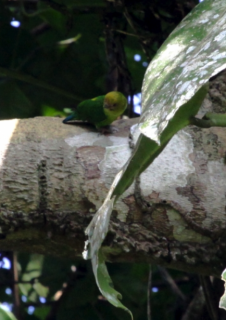Yellow-capped Pygmy Parrot |
|
|
Also known as: Kai Islands Pygmy Parrot
Photos
View in GalleryDid You Know?
The Yellow-capped Pygmy Parrot nests in an arboreal termitarium. Two eggs are laid in the unlined cavity and are incubated by the female, and possibly up to four other roosting "helper" adults.Academic Research
Related publications: Micropsitta keiensisSpecies Profile
Genus: Micropsitta | Species: keiensis
Size:
9.5cm (3.7 in)
Weight:
11-14g (0.4-0.5 oz)
Subspecies including nominate:
three: M.k. keiensis, M.k. viridipectus, M.k. chloroxantha
Colour Adult:
M.k. keiensis: Both adults mainly green; yellow crown, becoming dusky on forehead; brown face, changing to green on lower cheeks; yellow undertail coverts; blue central tail feathers; green/black lateral tail feathers. Bill grey. Eye brown.
M.k. viridipectus: Darker in general than keiensis; brown crown tinted with yellow.
M.k. chloroxantha: Male-orange/red centre of breast and abdomen, the remaining underparts yellow/green. Female-underparts all yellow/green; green/yellow crown.
Colour Juvenile:
M.k. keiensis: In general duller in colour. Bill yellow tipped with grey/brown.
M.k. viridipectus: As in adults.
M.k. chloroxantha: As in adult female.
Call:
Calls are high-pitched and squeaky notes repeated at short spans.
Listen NowVideo Links:
Video 1More Information:
Content Sources:
CITES
BirdLife International
Cornell Lab of Ornithology/Birds of the World
Parrots: A Guide to Parrots of the World, Juniper and Parr, 1998
Parrots of the World, Forshaw, 2006. 2010 edition
Lexicon of Parrots, Thomas Arndt.
Photos
View in GalleryDid You Know?
The Yellow-capped Pygmy Parrot nests in an arboreal termitarium. Two eggs are laid in the unlined cavity and are incubated by the female, and possibly up to four other roosting "helper" adults.Academic Research
Related publications: Micropsitta keiensisSpecies Care
Captive Status:
Not found in captivity.
Longevity:
Not recorded.
Housing:
Not recorded.
Diet:
Not recorded.
Enrichment:
Not recorded.
Nest Box Size:
Not recorded.
Clutch Size:
2
Incubation Time:
Not recorded.
Fledging Age:
Not recorded.
Hatch Weight:
Not recorded.
Peak Weight:
Not recorded.
Weaning Weight:
Not recorded.
Photos
View in GalleryDid You Know?
The Yellow-capped Pygmy Parrot nests in an arboreal termitarium. Two eggs are laid in the unlined cavity and are incubated by the female, and possibly up to four other roosting "helper" adults.Academic Research
Related publications: Micropsitta keiensisSpecies Wild Status
World Population:
Unknown, stable.
IUCN Red List Status:
Least Concern
CITES Listing:
Appendix II
Threat Summary:
Not globally threatened. Very common on Kai Island, scarce on Aru (apparently naturally). Is moderately common throughout W Papuan Islands.
Range:
M.k. keiensis: Kai and Aru Islands, Indonesia.
M.k. viridipectus: S New Guinea between Mimika and Fly Rivers.
M.k. chloroxantha: W Papuan Islands and on Vogelkop and Onin Peninsulas, Irian Jaya.
Habitat:
Found up to 550m (1804 ft) in lowland forest, secondary growth and sometimes around villages and in coconut groves.
Wild Diet:
Feeds on lichen, fungus, seeds, fruit and insects.
Ecology and Behaviour:
Generally are seen singly, in pairs or small groups, from the understorey to about 20m (65 ft) above ground. These birds clamber about trunks and limbs of trees, descending head first at times in their foraging activities.
Clutch and Egg Size:
2 eggs
Breeding Season:
September-March; nest is hollow in arboreal termite mound.
Related Links:
Photos
View in GalleryDid You Know?
The Yellow-capped Pygmy Parrot nests in an arboreal termitarium. Two eggs are laid in the unlined cavity and are incubated by the female, and possibly up to four other roosting "helper" adults.Academic Research
Related publications: Micropsitta keiensisMembers Only Resources
Please log-in now to find more research, resources and tools.
Not a Member?
Find more great information:
Gain exclusive access to 600+ pages of additional research, seminars and podcasts, specialists to ask your toughest questions, and dozens of other fun resources - when you become a WPT member.
Join Today >>

































